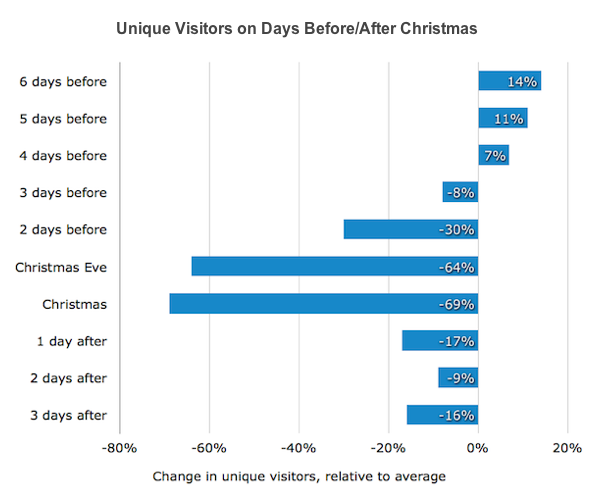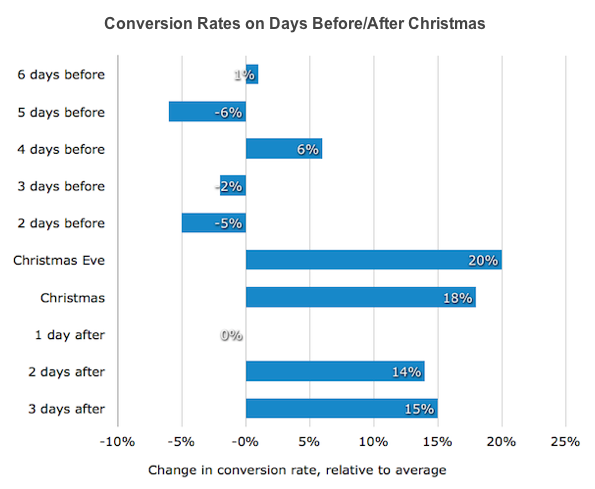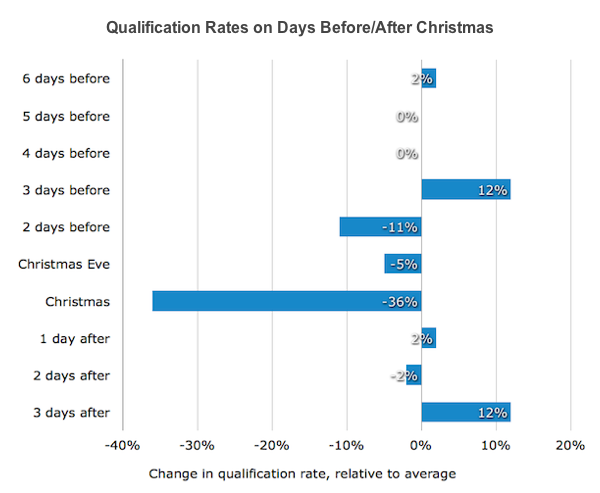by gabriel_sales | Dec 30, 2013
 2014 is nearly here, and before we make our resolutions and goals for next year, we wanted to take one last look at our best and most popular blogs of 2013. While we believe that many strategies, processes and tactics in B2B sales and marketing will change and evolve in the coming year (you can find our predictions for 2014 B2B sales and marketing trends here), many of things we worked so hard to develop last year will continue to be relevant.
2014 is nearly here, and before we make our resolutions and goals for next year, we wanted to take one last look at our best and most popular blogs of 2013. While we believe that many strategies, processes and tactics in B2B sales and marketing will change and evolve in the coming year (you can find our predictions for 2014 B2B sales and marketing trends here), many of things we worked so hard to develop last year will continue to be relevant.
Here are 5 of our most popular blog articles from 2013:
The Shift to Bought, then Sold
“…in today’s digital landscape, your buyers are becoming more self-directed. They want to buy on their own time and expect to be educated digitally. Only once they feel educated are they ready to be engaged by a sales rep.” Continue reading.
Marketing Automation is Not What You Think
“Nearly every business today is looking for ways to generate more leads and close more deals. Many companies are now looking to marketing automation as a means to achieve this and end up dissatisfied with the results. The reasons for dissatisfaction vary; some are challenged by the complexity of the software itself, others are frustrated by the software’s lack of integration with sales. Whatever the reason, we believe dissatisfaction with marketing automation stems from the same misunderstanding.” Continue reading.
B2B Buyer Personas: The 6 Types of B2B Buyers on the Internet
“As the buying process changed with the introduction of web-based technologies, buyers changed too. Buyers adapted new traits and behaviors conducive to the new digital space they occupy. By understanding these new traits or characteristics and incorporating these insights into your sales strategies, you can make better connections, earn more trust and ultimately, close more deals.” Continue reading.
3 Reasons Your B2B Sales is Failing
“Many B2B companies have started to catch on to the fact that marketing in the digital space is dramatically different than marketing of the past. Selling in this space means playing by different rules (i.e. the buyer runs the show), however, many companies have not taken the time to understand the complexities and intricacies these new rules contain.” Continue reading.
B2B Sales Pipeline Management
“B2B companies need to think of sales as a process to be managed that is backed by logic and data. Management of your sales process should be focused on your pipeline. A sales pipeline ‘is the amount of business you attempt to close in a given month, quarter or year’ (inc.com). You can manage the data of your sales pipeline using spreadsheets or sales and marketing technologies and then use that data to give you insights as to how to forecast better, improve your conversion rate and refine your marketing messages.” Continue reading.
If you would like to learn more, you can download our 2013 white paper called, New Rules for B2B Sales & Marketing in 2013. To learn about the B2B sales and marketing outsourcing services we offer, feel free to visit our services page.
Contact us with any questions.
by gabriel_sales | Dec 17, 2013
 A few weeks ago, we published a blog suggesting that you not slow down your B2B marketing efforts this holiday season. Software Advice recently released data collected from more than 6,000,000 unique visitors that supports and reinforces that Christmas advice.
A few weeks ago, we published a blog suggesting that you not slow down your B2B marketing efforts this holiday season. Software Advice recently released data collected from more than 6,000,000 unique visitors that supports and reinforces that Christmas advice.
Looking at the data, it seems the commonly held belief that ‘no one is in the office during the holidays’ may no longer be true. Or perhaps, it is all of the new mobile devices allowing businessmen to keep up with business from home while their kids are unwrapping presents.
Whatever the reason, the takeaway is clear: if other people are working during the holidays, you should be too.
We are not suggesting that you have your entire sales and marketing team come into the office on Christmas Day, but Software Advice’s research found that in terms of both web traffic and conversion activity, the days before and after Christmas see higher averages than one may expect:

(Source: Software Advice)
This graph shows that just four days before Christmas, the average web traffic is 7% higher than the monthly average. Additionally, web traffic is only slightly below the monthly average in the days following Christmas, showing that even if people are out of the office, they are still doing research on work-related purchase decisions online.

In terms of conversion (which is defined in this survey as submitting contact information via web form), the averages vary in the days before Christmas but are much higher than one would expect on the holiday itself as well as the days following. This suggests that Christmas Eve or Christmas Day are great times to send out nurture emails or a ‘holiday gift’ like an eBook download to initiate conversion. Additionally, because the B2B sales cycle is now typically three to six months, the more prospects you can convert in December, the better your sales pipeline will look at the end of Q1.

The data also shows that in terms of lead qualification, rates only deviate slightly from the monthly average in the week surrounding Christmas. Both three days before and three days after Christmas see a 12% higher conversion rate than the December average. This reinforces one of our own findings discussed in a previous blog: people who are in the office during the holidays have less work to do, and are therefore more likely to pick up the phone and be open to sales/marketing messages.
Summary:
- When it comes to B2B sales and marketing during the holidays, Software Advice’s research shows that companies stand to gain an advantage by putting in a little bit of extra effort.
- While many companies believe it is ineffective to staff sales reps and run marketing campaigns during the week of Christmas, average web traffic, conversion rates and qualification rates during this time suggest otherwise.
by gabriel_sales | Dec 13, 2013
 Building an emotional connection matters. While most people would assume that in terms of emotional connections with brands, B2C companies’ connections with their customers would be far stronger than those with B2B brands.
Building an emotional connection matters. While most people would assume that in terms of emotional connections with brands, B2C companies’ connections with their customers would be far stronger than those with B2B brands.
However, in a 2013 study by Google and CEB’s Marketing Leadership Council, the exact opposite was found:
“Of the hundreds of B2C brands that Motista has studied, most have emotional connections with between 10% and 40% of consumers. Meanwhile, of the nine B2B brands we studied, seven surpassed the 50% mark. On average, B2B customers are significantly more emotionally connected to their vendors and service providers than consumers.”
Google explained that while these findings may be initially surprising, the inner workings of B2B and B2C purchases give a clear explanation of why building an emotional connection matters: B2C purchases generally carry much less risk for the buyer than B2C purchases.
Most B2C purchases (a vacuum, a toothbrush, a pair of jeans, etc.) are returnable, and if they are not, the cost of a poor B2C product purchase is unlikely to affect someone’s overall wellbeing in any significant way. The same cannot be said for B2B purchases , which are generally much higher cost (i.e. a multi-million dollar software deal) and carry additional personal risks for the buyer:
-
Losing time and effort if a purchase decision goes poorly
-
Losing credibility if they make a recommendation for an unsuccessful purchase
-
Losing their job if they are responsible for a failed purchase
~Google
Because these personal risks carry a lot of emotional weight for the buyer, anything B2B companies can do reduce the level of perceived risk will strengthen the likelihood of a purchase being made. By highlighting the personal and emotional benefits of the B2B purchase (i.e. no more management headaches, opportunity to grow your career, etc.) in your early stage marketing content, you can help alleviate some of the emotional tension your prospects feel in their buying process. This is why this emotional connection matters so much.
To read more on reducing the perception of risk in B2B sales and why connection matters, click here.
Feel free to contact us with any questions.
by gabriel_sales | Dec 6, 2013
How social proof and marketing are inexplicably linked
While social proof is not a new phenomenon, its manifestation in the digital world has interesting effects and implications in terms of commercial attitudes and behaviors.
Evidence of the new power of social proof in commercial situations is everywhere—take Yelp! or Rotten Tomatoes for example. Millions of people now use social and interactive sites like these to help them make decisions about the products and services they buy. What is significant is that these digital opinions now have the power to upset the impact of traditional marketing and sales techniques.
Let’s look at Rotten Tomatoes. They have a score system that gives movies ratings by percentages. Having 75% positive reviews from registered movie critics makes a movie “Certified Fresh”. From a small startup in 1999, Rotten Tomatoes’ reviews and ratings are now “known to substantially affect the commercial success of many films,” and “Certified Fresh” stickers are now placed on the packaging of DVDs as a marketing tactic (Ross W. Martin).
The success of Rotten Tomatoes and similar sites shows us a couple of things. First is the growing distrust we have of traditional sources of information. Rather than listening to corporations who are always going to say their products and services are great, consumers are now starting to prefer to choose their purchases based on opinions they see as being more authentic and credible. This type of shift spans all industries and markets. In essence, consumers everywhere know they don’t have to listen to the industry equivalent of the ‘greasy car salesman’ anymore.
Consumers now want to feel educated and empowered when making buying decisions, and that cannot happen when they feel that they are ‘being sold’. As sociologists Gary Allen Fine and others have noted, “even when information becomes available from official sources, it will be believed only if people regard these sources as credible. When people view official sources as suspect or untrustworthy, they become increasingly likely to seek information from informal or unofficial sources.”
This brings us to the second thing sites like Rotten Tomatoes show us—the power of using social proof as a sales and marketing tactic. By letting other ‘indirect’ or ‘unofficial’ sources do the talking in your marketing content, you gain instant credibility. “Certified Fresh” stickers are a great example, and today’s smart companies are now finding many other new and inventive ways to leverage social proof through their sales and marketing campaigns.
Many companies who are using social proof in this way are doing so because they are seeing certain market trends develop:
- Over 70% of Americans say they look at product reviews before making a purchase. (Social Commerce Stats)
- Nearly 63% of consumers indicate they are more likely to purchase from a site if it has product ratings and reviews. (Search Engine Journal)
These statistics show that social proof is now a strong motivating factor in purchase decisions, and companies who demonstrate this through reviews and other means have an advantage over companies whose marketing tactics are purely promotional.
To learn more about how buyer’s digital behaviors are changing B2B sales and marketing, watch this quick overview video. Feel free to contact us with any questions.
by gabriel_sales | Nov 15, 2013
 In our previous blog post, we explained that the number one b2b selling mistake made today is selling too hard too soon. This blog outlines strategies for how not to make this mistake.
In our previous blog post, we explained that the number one b2b selling mistake made today is selling too hard too soon. This blog outlines strategies for how not to make this mistake.
In order sell in the right way at the right time, you need to understand where your prospect is in their buying cycle. The first way to do this is simple: listen to what they say.
If your prospect tells you he or she is looking for a solution for X but probably won’t have budget until next year, do not try to sell now. Instead, offer him or her basic, educational marketing content (like blogs, white papers, YouTube videos, etc.) that is nonthreatening but will keep your company’s name top of mind until your prospect has budget. If on the other hand, your prospect says they are trying to make a decision by the end of the week, it is the right time to pitch—hard.
A lot of times, however, your prospect is not going to be this direct, and you will have to use alternative means of determining when and when not to sell. This is where content marketing programs and marketing automation software become extremely valuable.
By mapping out your buying cycle and developing different pieces of marketing content to match each stage, you can then use a marketing automation platform to track which prospects are engaging in which content. When a prospect engages in first stage content, you know they need to be nurtured more. If a prospect clicks on a pricing page, it is probably time to pick up the phone.
By listening to your prospects’ behaviors—both explicitly and implicitly—you can ensure you don’t annoy or anger your prospects into going somewhere else because you tried to sell to hard too fast. When your prospects feel that you are listening to them and truly understand their needs, they are more likely to come back to you when they are ready to be sold.
To learn more about how people’s buying habits have changed in recent years and what to do to adapt, read our recent blog article called, “The Shift to ‘Bought, then Sold’”. Please feel free to contact us with any questions.
by gabriel_sales | Nov 14, 2013
 Most people working in sales today received their training from a generation of traditional salesmen who followed the traditional sales model. This model says to jump on new leads as soon as possible and sell hard and fast until the deal is closed.
Most people working in sales today received their training from a generation of traditional salesmen who followed the traditional sales model. This model says to jump on new leads as soon as possible and sell hard and fast until the deal is closed.
The thing that most salespeople today forget is that the traditional sales model was a product of its environment and today, that environment looks radically different.
In past decades, consumers had limited options for getting information on the products and services available to them and were therefore essentially forced into listening to high-pressured sales pitches. Today, consumers have the internet, smart phones and other digital technologies to help them learn about their buying options and make informed purchase decisions. What’s more, they have technologies like caller ID, spam filters and DVRs aimed at blocking out high-pressured sales pitches.
In this new type of sales environment, the number one mistake a salesman can make is selling too hard too fast.
If you try to sell too hard too soon, from the prospects’ perspective, you have become equivalent to that annoying TV commercial they fast forward through. They may have a need for your product/service one day, but because you were pushy and annoyed them instead of offering authentic information and guidance, they are going to go to your competitor.
In order to not make this mistake, you need to understand where your prospect is in their buying cycle to decide when and how to sell to them.
To continue reading, click here.
 2014 is nearly here, and before we make our resolutions and goals for next year, we wanted to take one last look at our best and most popular blogs of 2013. While we believe that many strategies, processes and tactics in B2B sales and marketing will change and evolve in the coming year (you can find our predictions for 2014 B2B sales and marketing trends here), many of things we worked so hard to develop last year will continue to be relevant.
2014 is nearly here, and before we make our resolutions and goals for next year, we wanted to take one last look at our best and most popular blogs of 2013. While we believe that many strategies, processes and tactics in B2B sales and marketing will change and evolve in the coming year (you can find our predictions for 2014 B2B sales and marketing trends here), many of things we worked so hard to develop last year will continue to be relevant.








